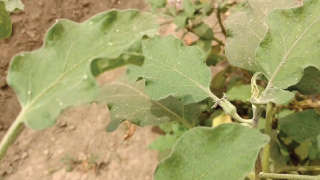
Guru GyaanAgroStar Agronomy Centre of Excellence
Consider these Precautionary Measures Prior to Transplanting Brinjal to Main Field
Brinjal is generally cultivated all through the year. The challenge associated is that some of the sucking insects, such as aphids, jassids, whiteflies, mites, shoots and fruit borers, etc., infest this crop. Little leaf viral disease is also seen in which no flowering or fruiting occurs in brinjal plants.
At the time of transplantation, below mentioned care should be taken to ensure a healthy crop and higher production at an early stage.
• The round brinjal fruit variety may be more affected by insect pests than the oblong fruit. Oblong varieties should, therefore, be preferred._x000D_
• The pests have less effect on the transplanted crop during September-October._x000D_
• Remove and destroy earlier crop residues before planting a new crop. Do not stack the residues of the crop on buds. If necessary cover them with a plastic net and keep one pheromone trap of fruit borer inside the net. _x000D_
• Select the seedling raised under the net house or from the nursery covered under the plastic net._x000D_
• Apply Carbofuran 3G@3 kg per Acre to the nursery before 2-3 days of pulling the seedlings._x000D_
• Maintain the distance between two rows and two plants as per soil type._x000D_
• Select healthy seedling for transplanting._x000D_
• Apply the recommended fertiliser to furrows instead of spreading on the soil._x000D_
• Collect and destroy damaged shoots along with larva or bury them in the soil to reduce further infestation._x000D_
• Install two Vota traps for shoot and fruit borer to monitor the pest. _x000D_
• Parasitism due to parasite (Trethela) is observed in more than 55% on shoot & fruit borer larva. Under these circumstances follow neem-based pesticides and conserve them. _x000D_
• On infestation of shoot & fruit borer, apply cow urine 20% along with leaf extract of neem, custard apple or lantana camera @10%._x000D_
• Periodically remove and destroy plants infected by little leaf disease._x000D_
• On increase in shoot damage, spray Chlorantraniliprole 18.5 SC @10 ml or Emamactin Benzoate 5 WG @4 g or Thiodicarb 75 WP @10 g per 10 litres of water._x000D_
Dr. T. M. Bharpoda,
Ex. Professor of Entomology,
B. A. College of Agriculture, Anand Agricultural University, Anand- 388 110 (Gujarat India)
If you find this information useful, click on the yellow thumbs up sign under the photo and also share this with your farmer friends using the options given below.
250
0

